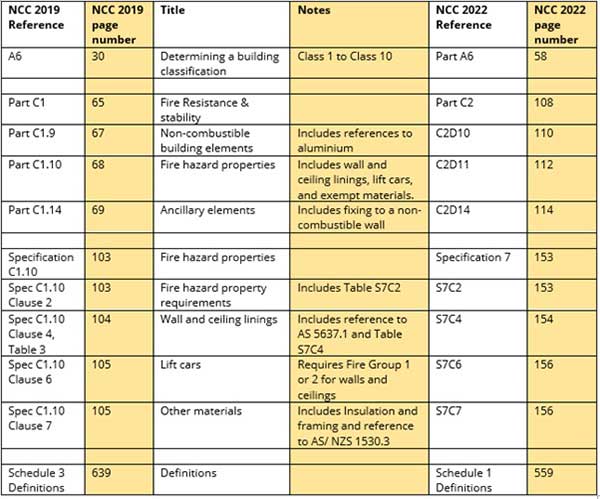Most of the new provisions of NCC 2022 took effect on 1 May 2023 in all states and territories across Australia.
There are three changes that affect linings:
- A new structure and clause referencing system has been implemented to make NCC 2022 more web-accessible.
- Fire safety of external walls – Non-combustibility requirements for attachments and linings of external walls has been clarified.
- Weatherproofing – Volume One contains additional DTS Provisions, including reference to AS 1562.1 as an acceptable solution for weatherproofing of external metal wall sheeting.
In this blog, we will cover the first one of these changes – the new structure and clause referencing system.
NCC 2022 clause numbering system
NCC 2022 uses a new structure and clause referencing system to make it more web-accessible.
Unfortunately, this means all the clause numbers you might have memorised have now changed. Here is a cross-reference guide to help you find the new clause reference number from the old clause numbers:
The NCC uses a uniform clause numbering system across each of its three volumes. This system is called Section-Part-Type-Clause (SPTC).
The letters used in the clause numbering system indicate the following:
S = Specification (a high-level overview)
G = Governing requirement (mandatory)
O = Objective (guidance)
F = Functional Statement (guidance)
P = Performance Requirement (mandatory)
V = Verification Method (optional)
D = Deemed-to-Satisfy Provision (optional)
C = Clause in a Specification (clauses in Specifications may be mandatory or optional, depending on how the Specification is called up by the NCC).
Here is an extract of the cross-reference guide, showing the new Clause reference number from the old Clause numbers, relating to internal linings.
As an extra bonus, we have added some notes and the page numbers.

Purpose of NCC Volume One 2022 changes
The purpose of NCC Volume One 2022 changes is to:
- include quantified performance requirements
- clarify and improve provisions relating to fire performance of building elements, including external walls
- include provisions to improve fire safety for early childhood centres and primary schools
- include expanded weatherproofing and waterproofing provisions
- include bushfire protection requirements for certain Class 9 buildings
- incorporate amended energy efficiency provisions
How Supawood can help
As well as the guides above, Supawood can help with any details relating to decorative and acoustic linings that may be needed by a designer, builder, or installer.
This includes fire compliance, seismic engineering, optimising the internal acoustic performance of a space, or how best to achieve Green Star, Living Building Challenge, WELL or LEED sustainability status.

